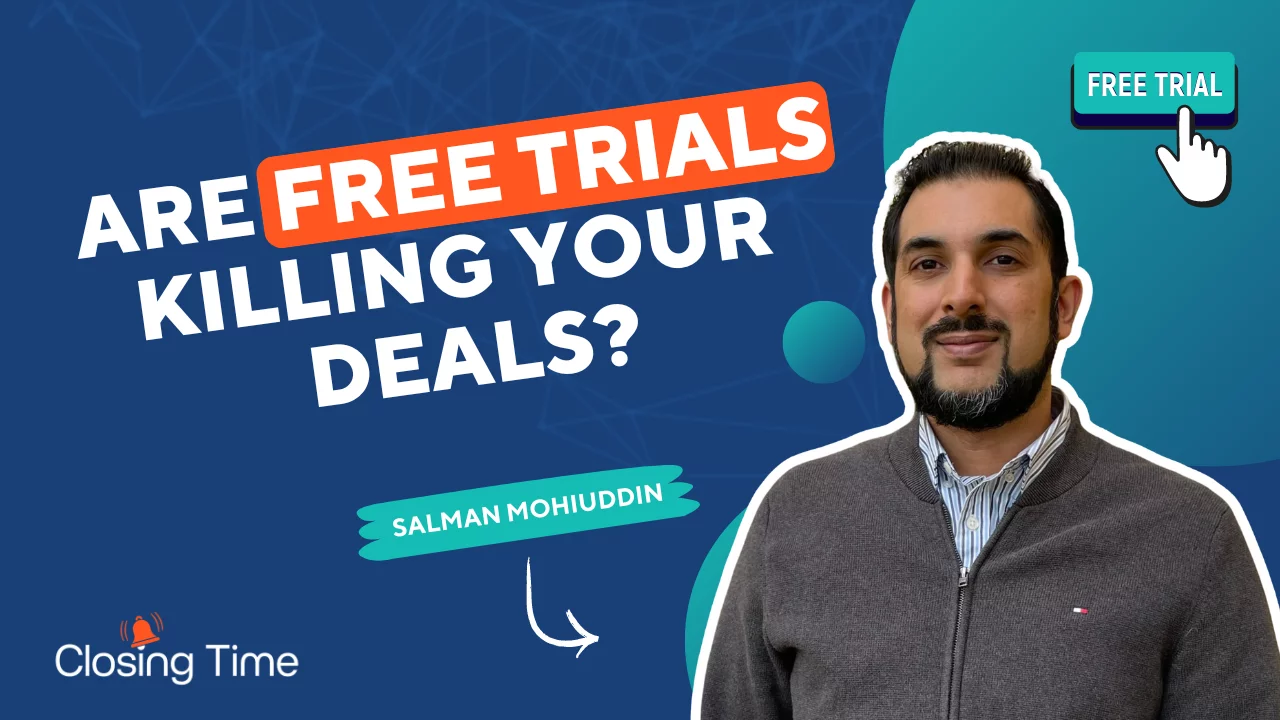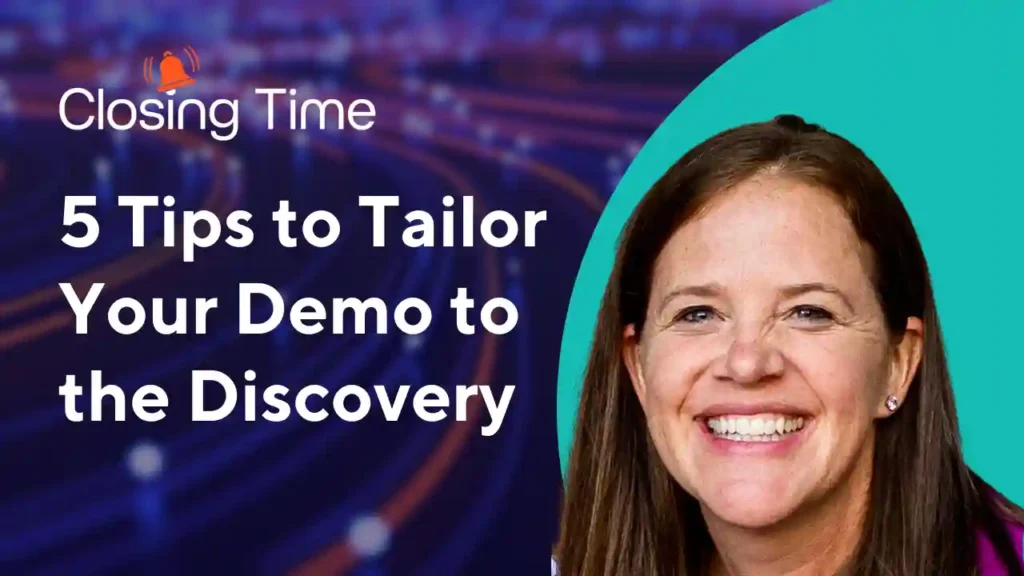Don’t let your deal die at the trial stage.
Get a framework to consistently have successful trials
to close a deal in this episode of Closing Time.
Thanks for tuning in to closing time the show for Go to Market Leaders.
I’m Dave Osborne, chief Sales officer at Insightly CRM.
I’m joined today by Salman Mohiuddin, a sales
trainer and coach and owner of Salman Sales Academy.
Thanks for joining, Salman.
Pleasure to be here, David.
All right.
So, you know, today
we’re going to talk about something that I’ve seen just a lot of inexperienced
reps fall into this trap, the consistent trap
where they’re doing large enterprise deals, SMB deals, mid market deals.
It’s the trap of creating a trial. Right.
Which sounds really great on the surface,. Right?
I mean, giving them hands on experience in the product.
But if you don’t think about the trial the right way,
it can be a recipe for disaster for your sales motion.
Right.
And protract the cycle back several weeks if you don’t think about it right.
So Salman I’d love to hear a little bit your opinion.
Like, has that been your experience
or how do you see trials being effectively utilized in sales campaigns?
Well,. David, I was one of those inexperienced
reps early in my career where I got happy ears
when a prospect says after the demo,. Hey, this look great,
can we get a trial to play around with the platform?
I was like, Heck yeah, let’s do it.
I was like, I told my manager, Hey,. I got them a trial.
They’re going to trial for 30 days.
It’s going to go awesome.
And I got excited.
And what happened?
Really Nothing.
I tried following up.
I didn’t hear anything.
When I did get a hold of them, they said, Hey, listen Salman, we’re
really, really busy.
We haven’t had a chance to even log into the platform.
Two weeks, three weeks passed by.
It wasn’t a real deal in the first place, and the only person I can blame
is the person in the mirror. Right.
So I think that a lot of reps face this because they feel like
if somebody is wanting to try their solution, that is a buying signal.
But in fact, what you need to understand is understanding the why behind that.
What’s driving you to look at a trial?
Because surprisingly enough, you might be able to not even have
to give out a trial.
Maybe there’s a feature or a functionality that you can show in the demo
or another call really quickly that will shed away their concerns.
So I think understanding the why before even giving a trial is the key thing.
Yeah, 100%.
I think we’ve all fallen into that trap.
Right.
So it’s what, like what are you hoping to get out of this trial?
Right. What is?
And I suppose the next thing you’re trying to figure out
is what does a successful trial look like?
Right?
Like, what are the criteria that you’re looking to evaluate?
Yeah, totally.
So I think, like, if they come back and say, for example, hey,
we’re required to look at a trial, we’ve been doing this for many years where
if we’re looking at three or four vendors, it’s our buying process
where we need to look at and try out the solution before we make a decision.
So if that’s clear cut and you understand the why behind that
then that’s totally fine.
And yes, companies do give trials.
We obviously can give a trial for 30 days.
Sometimes you can even get it from the website.
But if you’re just throwing them around
like hotcakes, it’s not a recipe for success.
And I learned the hard way many, many, many times.
Right. And it didn’t look good on me.
So number one, to your point,. David is, you know, share
something where you can say, hey, listen, I totally understand.
There’s three things we want to make sure we’re aligned with our customers
before we had a trial to ensure we’re aligned and ensure their success.
Do you mind if I walk you through that?. Yeah, sure.
And the first one, to your point, is understanding what the use cases are.
And you know, from your experience, David,
you’ve been at Qualtrics for many, many years and now at Insightly is that
you need
to understand what the use cases are, deals are use case driven, right?
If you just uncover a problem,. Oh, look, we’re looking to solve
our customer data scattered across multiple different systems.
Okay, fine.
But what is the use case that it’s tied to?
Because if there’s no use case, there’s no deal.
And you know this right. Deals are use case driven.
So the first thing you want to understand
and typically you should do this in discovery because here’s the thing.
A lot of people, a lot of sellers miss this.
Your customers are getting the job done today without your product.
That’s just a reality.. I don’t care how good your product is.
They’re getting it, but it may not be the most efficient way.
It may not be an automated way and be very tough for them to uncover
how they’re getting it done and tie that to a use case
and once you get into that discussion of a trial, first, you want to ask them
what are the two or three use cases you try to
prove out?
And if you’ve done that, you can document that, have that in writing to understand
what are these cases that is going to ensure this is a success.
That’s the first thing.
Yeah.
And I suppose depending on what those are, that can also help
dictate the timeline, right?
Because maybe you have the authorization to run a 30 day trial.
Right.
But based on the use case they’re looking to explore,
they might need a week, they may need a few days.
And you could you could reorient accordingly,
because time kills all deals, as we know.
And If we haven’t set up that success criteria,
if we haven’t properly enabled them to
accomplish what they’re looking to get out of it, chances are
they’re just going to sit on it, like you said.
And I think part of this is what happens.
I mean, this is someone who’s never used your product
and you might have the most easy to use product on earth.
Right? Let’s let’s say that you do.
Most CPOs would probably say that they do.
But this is the first time ever use something like this.
So when they have questions, when they have issues, just handing them
the keys to the car and turning them loose seems a little bit tricky.
So what’s your approach to making sure that they’re achieving
what they want and answering questions during that trial period?
Yeah, I think it starts with firstly, after you’ve outlined those use cases,
understand what is success mean to them,
not what it means to you.
What does it mean to you progressing the deal, making sure they fall in love
with the product, make sure you close that deal rather than letting it progress.
That’s fine.
But hey, think about your customers best interests before your own.
What?
How do they measure success?
What is their key success criteria?
And you have to map that out early
because then there’s no purpose and intention to your trial.
Then it’s all about you, You, you.
It has to be about the customer.
So mapping out what that success criteria is and outlining that on that call
when they bring it up.
For example, is success, ease of use
for their team, especially if they’re non tech users?
Is it proving out the use cases in a timely fashion?
Is it the amount of time that they’re going
to be saving so they can work on more mission critical issues?
Is it increasing productivity and decreasing manual work?
Is it conversion rates if they’re in marketing?
Understanding and mapping out those two or three or four key success criteria
and addition to that, getting an agreement from them that, hey, hey, if we
if you meet the success criteria at the end of the 14 day,
30 day trial, whatever you want to call it, David.
That if we agree to that and we meet those expectations
and success criteria, what does a roll out plan look like
to the broader team in a license contract?
Right.. So that’s what you want to understand.
That’s key. Yeah.
I mean, clarifying the close, right, is do you have intent to buy, Right.
Because you know, we don’t want you just kicking the tires.
It’s assuming we check all these boxes of what you’re looking to accomplish.
Is it your intention to to move forward with the contract?
And if so, what does that look like?
I love that.
I think as well with some of these success criteria.
And I’m curious if your opinion on this is
a couple different things.
I think there’s a little bit of strategy that can go into this.
So number one, I think vague success criteria doesn’t necessarily help you.
So, for example, ease of use, hey, we just want to make sure
it’s really easy to use. Well, how are we going to measure that?
How do we how can we check that box?
Because that’s a very subjective thing versus,
you know, maybe something a lot more clear, right?
Like we want to be able to measure X by Y as measured by Z or,
you know, like you mentioned conversion rates or, you know, I guess I suppose
it would depend on the product, but I mean, I think there needs
to be a healthy amount of pushback or give and take in terms of what you can,
what we can accomplish or what success criteria is.
Right?
It’s not necessarily fully on the customer to establish that.
I think it’s got to be a mutually agreed upon contract, right?
Yeah. Yeah.
And you hit the nail on the head there.
It comes down to KPIs and metrics that are important to the buyer.
So one of the questions that I really like uncovering in discovery is,
you know, typically what we find is a lot a lot of leaders like yourself
are measured on some sort of metric or KPI, whether it be X, Y or Z.
What KPI or metric are you accountable for for your team?
How is that KPI or metric being affected by this problem that you’re facing?
What is the target you’re trying to hit?
What does that gap look like?
So understanding that in discovery can help you map out what that success
criteria is to make it more specific rather than vague.
Love that.
So Salman,. I think another part of this process
that I think is often overlooked, right, is how and when to engage
the executive sponsor of your buyer into the cycle and specifically
in the trial process, right?
I mean, maybe you’re dealing with a front line individual, right,
that has a very, very vested interest in the success of this.
But we know that deal’s probably not going to get done without the execs blessing.
So we’d love to hear your approach and like how and why
is kind of a best practice to to leverage those executives on the buy side.
Yeah.
This is one of the most important items, David.
And you know, something that I struggled with early in my career
is I can’t tell you how many deals I lost when a CIO and a CTO
CMO kind of crushed the deal, came in late and said, Hey, we’re not doing this.
And that was on me, completely on me, because number one, I didn’t
uncover power early and number two, and I didn’t align with them.
And I didn’t maintain that alignment throughout the entire deal cycle.
So that was completely on me.
But I learned my lesson
and what I learned is, number one, you got to uncover power early
on your discovery calls because
there might be an executive sponsor that’s driving this initiative.
Who might that be? Right.
Is this a common problem that comes up in exec level meetings?
Why is it important?
Who is important to? Uncover who that is the first thing.
And number two, when it comes to that trial discussion,
you have to have that executive sponsorship.
So in addition to asking for those times to say, hey,
we need to meet so many times per week, is that you know, what’s made
these trials and pilots most
successful is ensuring there’s executive alignment on both sides.
And in the spirit of our partnership, what I like to do is
ask for an executive alignment, maybe midpoint or later part of this trial
to ensure our line on both sides without be a fair ask.
And having that executive alignment is going to be super, super key
early and throughout that cycle, especially when you’re talking about
trials because it’s a give and get.
If I’m giving you a demo,
if I’m giving you a trial,. I got to get something in return.
And that’s an executive sponsorship for example.
I love that.
And if it’s something that
maybe it’s a struggle, maybe they have an initial pushback on.
I think another card you can play is we’d love to get
our VP on the phone with your VP.
Right, Let’s match exec sponsors, right.
Like, let’s get the right folks to the call,
even if it’s briefly just to make sure we’re aligned on expectations
and really where this is going to ensure the best possible experience.
100%. So
we’ve agreed to a trial.
We set it up. Let’s say it’s a two week trial.
We set up three success criteria.
And if we if we meet these expectations, we’re
going to move forward with the contract, ready to kick off the trial.
We’re not going to just hand them the keys to the car.
Right.
So I’d love to hear
kind of your thoughts or process on kind of outlining this plan of attack.
Right.
So we’re going to kick off the trial with this.
And then I, I would assume that there’s going to be different check ins or touch
points throughout that trial experience to ensure that
we’re hitting those success criteria.
Totally.
I’m a big believer, David, that the biggest differentiator
that you have as a business, as an organization, as a brand,
the biggest competitive differentiator is your customers buying experience with
you and your brand.
How do you make it so that no
one other vendor that they’re working with gives them this experience?
I’m a big believer for your key deals or any deal, you have to do this.
You provide that white glove service, they’re going to be like, Wow,
this was the best piloted trial I’ve ever had.
They helped me along the way.
They answered the questions.
They got their cross-functional teams involved to ensure we were successful.
They answered questions in real time.. That’s what you want, right?
But how do you do that?
You provide the resources that they need and you let them know, Hey, listen,
when we kick off this trial, typically there’s a lot of questions
that come a back and forth rather than go via email.
What I like to do, with your permission, is map out a couple of calls over
the next couple of weeks to ensure we’re aligned and not just bring yourself.
For example, the traditional customer success
team usually gets involved after the close, right?
That’s the way it works traditionally, right?
But I say, why not give them a preview of what they’re going to get
when they actually buy?
Bring your Customer success manager out early.
Have them walk them through some best practices
that they should be looking out for, answering questions on the fly.
Give them that white glove service.
And if you’re aligned on that and you map those mutual timelines
in terms of when to have those calls, that’s going to show them
that you care and that you’re putting their best interests before your own.
Totally agree.
Totally agree.
And keep in mind, trials aren’t necessary for every single deal.
So sellers
don’t go out there trying to force people into a trial account, even if it’s a
really strong product and your CEO’s a product-led person
and really wants that, it’s not necessarily appropriate.
Right?
Trials can be a great facilitator, and differentiator in a sales cycle
when done correctly, but can also protract the deal
several weeks or several months in some cases if done poorly.
So really critical that you approach this the right way.
Salman, really, really appreciate the time.
That’s that’s that’s all the time we have for today.
But where can folks connect with you and learn more about your methodology
and your training philosophy?
Yeah, connect maybe on LinkedIn,
Salman Mohiuddin on LinkedIn you’ll find all my sites and landing pages there.
Send me a DM, you can go to SalmanSalesAcademy.com..
But we’re launching a new website in early August so you can find me there.
Awesome.
Awesome.
Well, Salman, really appreciate you joining us today.
Thanks alot, David. Appreciate it.
And thanks to all of you for tuning in.
Remember to like this video,. Subscribe to the channel
and tick the bell for notifications so you don’t miss an episode.
We’ll see you next time on closing time.




